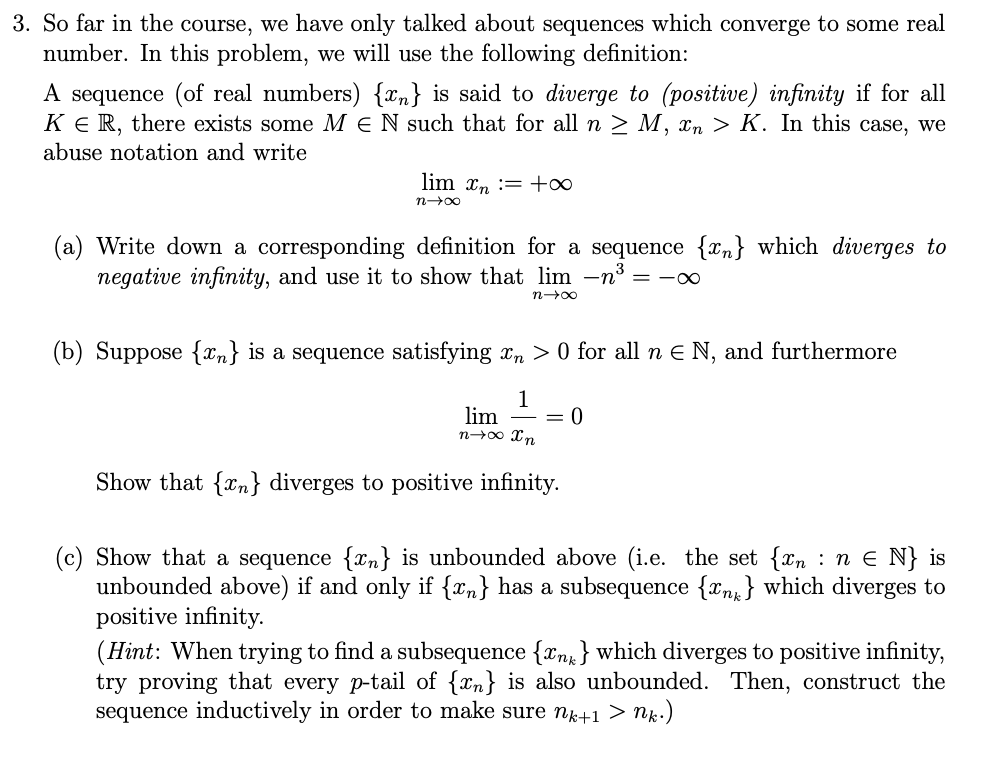3. So far in the course, we have only talked about sequences which converge to some real number. In this problem, we will use the following definition: A sequence (of real numbers) {n} is said to diverge to (positive) infinity if for all KER, there exists some MEN such that for all n ≥ M, xn > K. In this case, we abuse notation and write lim n = +∞ n→∞ (a) Write down a corresponding definition for a sequence {n} which diverges to negative infinity, and use it to show that lim -n³ = -∞ n→∞ (b) Suppose {n} is a sequence satisfying xn> 0 for all n € N, and furthermore 1 lim = 0 n→∞ Xn Show that {n} diverges to positive infinity. (c) Show that a sequence {x} is unbounded above (i.e. the set {xn: :n € N} is unbounded above) if and only if {n} has a subsequence {n} which diverges to positive infinity. (Hint: When trying to find a subsequence {n} which diverges to positive infinity, try proving that every p-tail of {n} is also unbounded. Then, construct the sequence inductively in order to make sure nk+1 > nk.)
3. So far in the course, we have only talked about sequences which converge to some real number. In this problem, we will use the following definition: A sequence (of real numbers) {n} is said to diverge to (positive) infinity if for all KER, there exists some MEN such that for all n ≥ M, xn > K. In this case, we abuse notation and write lim n = +∞ n→∞ (a) Write down a corresponding definition for a sequence {n} which diverges to negative infinity, and use it to show that lim -n³ = -∞ n→∞ (b) Suppose {n} is a sequence satisfying xn> 0 for all n € N, and furthermore 1 lim = 0 n→∞ Xn Show that {n} diverges to positive infinity. (c) Show that a sequence {x} is unbounded above (i.e. the set {xn: :n € N} is unbounded above) if and only if {n} has a subsequence {n} which diverges to positive infinity. (Hint: When trying to find a subsequence {n} which diverges to positive infinity, try proving that every p-tail of {n} is also unbounded. Then, construct the sequence inductively in order to make sure nk+1 > nk.)
Algebra & Trigonometry with Analytic Geometry
13th Edition
ISBN:9781133382119
Author:Swokowski
Publisher:Swokowski
Chapter10: Sequences, Series, And Probability
Section: Chapter Questions
Problem 63RE
Related questions
Question

Transcribed Image Text:3. So far in the course, we have only talked about sequences which converge to some real
number. In this problem, we will use the following definition:
A sequence (of real numbers) {n} is said to diverge to (positive) infinity if for all
KER, there exists some MEN such that for all n ≥ M, xn > K. In this case, we
abuse notation and write
lim n = +∞
n→∞
(a) Write down a corresponding definition for a sequence {n} which diverges to
negative infinity, and use it to show that lim -n³ = -∞
n→∞
(b) Suppose {n} is a sequence satisfying xn> 0 for all n € N, and furthermore
1
lim = 0
n→∞ Xn
Show that {n} diverges to positive infinity.
(c) Show that a sequence {x} is unbounded above (i.e. the set {xn: :n € N} is
unbounded above) if and only if {n} has a subsequence {n} which diverges to
positive infinity.
(Hint: When trying to find a subsequence {n} which diverges to positive infinity,
try proving that every p-tail of {n} is also unbounded. Then, construct the
sequence inductively in order to make sure nk+1 > nk.)
Expert Solution
This question has been solved!
Explore an expertly crafted, step-by-step solution for a thorough understanding of key concepts.
This is a popular solution!
Trending now
This is a popular solution!
Step by step
Solved in 4 steps with 4 images

Recommended textbooks for you

Algebra & Trigonometry with Analytic Geometry
Algebra
ISBN:
9781133382119
Author:
Swokowski
Publisher:
Cengage

Algebra & Trigonometry with Analytic Geometry
Algebra
ISBN:
9781133382119
Author:
Swokowski
Publisher:
Cengage